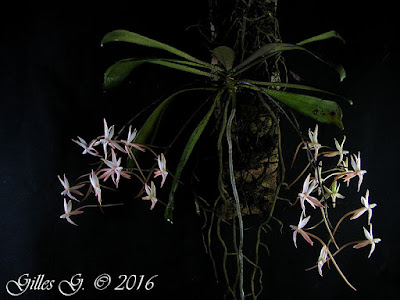Aerangis arachnopus has been collected in Cameroon, Congo, Gabon, Zaire, and possibly Ghana. The plants are found in evergreen forest below 1000 m, and they growing profusely on old citrus trees in an abandoned garden at 400 m.
Aerangis arachnopus also called as The Spider-Like Column Foot Aerangis, Aerangis batesii, Aerangis biloboides, Angorchis arachnopus, Angraecum arachnopus, Angraecum batesii, Angraecum biloboides, Rhaphidorhynchus batesii, is a species of the genus Aerangis. This species was described by Friedrich Richard Rudolf Schlechter in 1918.
IDENTIFY AERANGIS ARACHNOPUS ORCHID PLANT
Aerangis arachnopus has been collected in Cameroon, Congo, Gabon, Zaire, and possibly Ghana. The plants are found in evergreen forest below 1000 m, and they growing profusely on old citrus trees in an abandoned garden at 400 m.
It is a short, monopodial epiphyte with 4 to 6, oblanceolate to obovate, rather light green, unequally and obtusely bilobed apically leaves borne in a fan-shape.
The Spider-Like Column Foot blooms in the spring on a pendant, very slender, to 60 cm long, fractiflex rachis, 3 to 8 flowered inflorescence. The flowers are white but the floral segments are strongly tinged with pink toward their tips.
AERANGIS ARACHNOPUS ORCHID PLANT CARE AND CULTURE
Cultural information should only be used as a guide, and should be to be adapted to suit you. Your physical location; where you grow your plants, how much time you have to devote to their care, and many other factors, will need to be taken into account. Only then can you decide on the cultural methods that best suit you and your plants.
Light:
Aerangis arachnopus needs a light level of 15000-23000 lux. Light should be filtered or diffused, and plants should not be exposed to direct midday sun. Strong air movement should be provided at all times. The plants should be grown in moderate shade.
Temperature:
Summer days temperature at average of 29-30°C, and nights temperature average 20°C, with a diurnal range of 9-10°C.
Humidity:
The Spider-Like Column Foot need the humidity of 80-85% most of the year, dropping to near 75% for about 2 months in late winter and early spring.
Substrate, growing media and repotting:
Aerangis arachnopus usually grows better and its pendent flower spikes are more easily displayed when plants are mounted on slabs of rough bark. Mounted plants need high humidity and must be watered or misted at least once a day, however, and during hot, dry weather they may require several waterings a day.
They may also be grown in small 3-5 in. (8-13 cm) hanging pots or baskets using a very coarse, open, fast-draining medium to anchor the plant but allowing the roots to wander outside the container.
Plants should be repotted if the medium starts to break down. Repotting done just as new roots start to grow enables the plant to become reestablished in the shortest possible time. If the leaves start to shrivel or wrinkle or show other signs of stress, the plant usually will recover and grow well if soaked in water for about 20 minutes at least 3 times a week.
Watering:
Rainfall in the habitat is heavy most of the year, with 2-3 rather dry months in winter. Cultivated plants should be watered heavily while actively growing. Water should be reduced somewhat in late autumn.
Fertilizer:
1/4-1/2 recommended strength, applied weekly when plants are actively growing. You can use a balanced fertilizer throughout the year; but also can use a high-nitrogen fertilizer from spring to midsummer, then switch to one high in phosphates in late summer and autumn.
Rest period:
In winter, the days temperature is at average 27-28°C, and nights average 18-19°C, with a diurnal range of 9-10°C. The plants grow well in intermediate conditions, but may grow better under slightly warmer conditions. Cultivated plants need less in winter, but they should never dry out completely or remain without water for long periods. In most growing areas, somewhat regular early-morning misting between occasional light waterings should provide the dry rest without letting the plant become too dry. Fertilizer should be reduced or eliminated when water is reduced.















COMMENTS